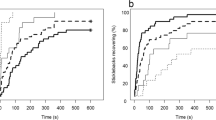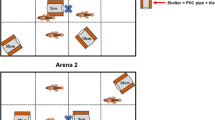Abstract
There is growing interest in the ecological consequences of fear, as evidenced by the numerous studies on the nonconsumptive, trait-mediated effects of predators. Parasitism, however, has yet to be fully integrated into research on the ecology of fear, despite it having direct negative and often lethal effects on hosts and being the most common life history strategy on the planet. This might at least be partly due to the traditional, but untested, assumption that anti-parasite responses are weak relative to anti-predator responses. To test this hypothesis, we quantified the activity and location responses of Bufo americanus tadpoles to one of six chemical cues: water; cercariae of Echinostoma trivolvis, a trematode which infects and can kill amphibians; a snail releasing E. trivolvis cercariae; an uninfected snail; food; or conspecific alarm chemicals signaling predation. There is also literature encouraging research on the context dependency and pollution-induced disruption of fear responses. Consequently, before quantifying responses to the chemical cues, half of the B. americanus were exposed to the herbicide atrazine (201 μg/l for 4 days), a reported inhibitor of fear responses in fish. Tadpoles were attracted to food, were indifferent to an uninfected snail, avoided alarm chemicals, and exhibited avoidance and elevated activity in response to a snail shedding cercariae and cercariae alone. Atrazine had no detectable effects on B. americanus’ responses to the tested cues despite the use of a higher concentration and longer exposure duration than has been repeatedly shown to inhibit chemical cue detection in fish. The magnitude of anti-parasite and anti-predator responses were qualitatively similar, suggesting that the fear of disease and its ecological consequences could be comparable to that of predation. Consequently, we call for a greater integration of parasites into research on the ecology of fear and trait-mediated indirect effects.

Similar content being viewed by others
References
Anderson RM, May RM (eds) (1982) The population biology of infectious disease. Springer, Berlin
Baker RL, Smith BP (1997) Conflict between antipredator and antiparasite behaviour in larval damselflies. Oecologia 109:622–628
Blumstein DT (2006) Developing an evolutionary ecology of fear: how life history and natural history traits affect disturbance tolerance in birds. Anim Behav 71:389–399
Bolker B, Holyoak M, Krivan V, Rowe L, Schmitz O (2003) Connecting theoretical and empirical studies of trait-mediated interactions. Ecology 84:1101–1114
Bolnick DI, Preisser EL (2005) Resource competition modifies the strength of trait-mediated predator–prey interactions: a meta-analysis. Ecology 86:2771–2779
Carr JA et al (2003) Response of larval Xenopus laevis to atrazine: assessment of growth, metamorphosis, and gonadal and laryngeal morphology. Environ Toxicol Chem 22:396–405
Cohen LM, Neimark H, Eveland LK (1980) Schistomsoma mansoni: response of cercariae to a thermal gradient. J Parasitol 66:362–364
Daszak P, Cunningham AA, Hyatt AD (2003) Infectious disease and amphibian population declines. Divers Distrib 9:141–150
Decaestecker E, De Meester L, Ebert D (2002) In deep trouble: habitat selection constrained by multiple enemies in zooplankton. Proc Natl Acad Sci USA 99:5481–5485
Dobson AP, Hudson PJ (1986) Parasites, disease and the structure of ecological communities. Trends Ecol Evol 1:11–15
Dodson SI, Crowl TA, Peckarsky BL, Kats LB, Covich AP, Culp JM (1994) Nonvisual communication in freshwater benthos: an overview. J N Am Benthol Soc 13:268–282
Ezenwa VO (2004) Selective defecation and selective foraging: antiparasite behavior in wild ungulates? Ethology 110:851–862
Forson DD, Storfer A (2006) Atrazine increases ranavirus susceptibility in the tiger salamander, Ambystoma tigrinum. Ecol Appl 16:2325–2332
Fried B, Pane PL, Reddy A (1997) Experimental infection of Rana pipiens tadpoles with Echinostoma trivolvis cercariae. Parasitol Res 83:666–669
Gosner N (1960) A simplified table for staging anuran embryos and larvae with notes on identification. Herpetologica 16:183–190
Hayes TB et al (2002) Hermaphroditic, demasculinized frogs after exposure to the herbicide atrazine at low ecologically relevant doses. Proc Natl Acad Sci USA 99:5476–5480
Holland MP, Skelly DK, Kashgarin M, Bolden SR, Harrison LM, Cappello M (2007) Echinostome infection in green frogs (Rana clamitans) is stage and age dependent. J Zool 271:455–462
Johnson PTJ, Sutherland DR (2003) Amphibian deformities and Ribeiroia infection: an emerging helminthiasis. Trends Parasitol 19:332–335
Karvonen A, Seppala O, Valtonen ET (2004) Parasite resistance and avoidance behaviour in preventing eye fluke infections in fish. Parasitology 129:159–164
Kiely T, Donaldson D, Grube A (2004) Pesticide industry sales and usage: 2000 and 2001 market estimates. US Environmental Protection Agency, Washington
Kiesecker JM (2002) Synergism between trematode infection and pesticide exposure: a link to amphibian limb deformities in nature? Proc Natl Acad Sci USA 99:9900–9904
Kiesecker JM, Skelly DK (2000) Choice of oviposition site by gray treefrogs: the role of potential parasitic infection. Ecology 81:2939–2943
Kiesecker JM, Skelly DK, Beard KH, Preisser E (1999) Behavioral reduction of infection risk. Proc Natl Acad Sci USA 96:9165–9168
Koprivnikar J, Forbes MR, Baker RL (2006) On the efficacy of anti-parasite behaviour: a case study of tadpole susceptibility to cercariae of Echinostoma trivolvis. Can J Zool 84:1623–1629
Lawler JJ et al (2006) Conservation science: a 20-year report card. Front Ecol Environ 4:473–480
Lima SL (1998) Nonlethal effects in the ecology of predator–prey interactions: what are the ecological effects of anti-predator decision-making? Bioscience 48:25–34
Liu XM, Shao JZ, Xiang LX, Chen XY (2006) Cytotoxic effects and apoptosis induction of atrazine in a grass carp (Ctenopharyngodon idellus) cell line. Environ Toxicol 21:80–89
Lurling M, Scheffer M (2007) Info-disruption: pollution and the transfer of chemical information between organisms. Trends Ecol Evol 22:374–379
Martin TR, Conn DB (1990) The pathogenicity, localization, and cyst structure of Echinostomatid metacercariae (Trematoda) infecting the kidneys of the frogs Rana clamitans and Rana pipiens. J Parasitol 76:414–419
Moore A, Lower N (2001) The impact of two pesticides on olfactory-mediated endocrine function in mature male Atlantic salmon (Salmo salar L.) parr. Comp Biochem Physiol B Biochem Mol Biol 129:269–276
Moore A, Waring CP (1998) Mechanistic effects of a triazine pesticide on reproductive endocrine function in mature male Atlantic salmon (Salmo salar L.) parr. Pest Biochem Physiol 62:41–50
Mouritsen KN, Poulin R (2005) Parasites boosts biodiversity and changes animal community structure by trait-mediated indirect effects. Oikos 108:344–350
Park D, Propper CR (2002) Endosulfan affects pheromonal detection and glands in the male red-spotted newt, Notophthalmus viridescens. Bull Environ Contam Toxicol 69:609–616
Park D, Hempleman SC, Propper CR (2001) Endosulfan exposure disrupts pheromonal systems in the red-spotted newt: a mechanism for subtle effects of environmental chemicals. Environ Health Perspect 109:669–673
Petranka JW (1989) Response of toad tadpoles to conflicting chemical stimuli: predator avoidance versus optimal foraging. Herpetologica 45:283–292
Petranka J, Hayes L (1998) Chemically mediated avoidance of a predatory odonate (Anax junius) by American toad (Bufo americanus) and wood frog (Rana sylvatica) tadpoles. Behav Ecol Sociobiol 42:263–271
Preisser EL, Bolnick DI, Benard MF (2005) Scared to death? The effects of intimidation and consumption in predator-prey interactions. Ecology 86:501–509
Raffel TR, Martin LB, Rohr JR (2008) Parasites as predators: unifying natural enemy ecology. Trends Ecol Evol 23:610–618
Relyea R, Hoverman J (2006) Assessing the ecology in ecotoxicology: a review and synthesis in freshwater systems. Ecol Lett 9:1157–1171
Ripple WJ, Beschta RL (2004) Wolves and the ecology of fear: can predation risk structure ecosystems? Bioscience 54:755–766
Rohr JR, Crumrine PW (2005) Effects of an herbicide and an insecticide on pond community structure and processes. Ecol Appl 15:1135–1147
Rohr JR, Madison DM (2001) A chemically mediated trade-off between predation risk and mate search in newts. Anim Behav 62:863–869
Rohr JR, Palmer BD (2005) Aquatic herbicide exposure increases salamander desiccation risk eight months later in a terrestrial environment. Environ Toxicol Chem 24:1253–1258
Rohr JR, Madison DM, Sullivan AM (2002a) The ontogeny of chemically-mediated antipredator behaviours in newts (Notophthalmus viridescens): responses to injured and non-injured conspecifics. Behaviour 139:1043–1060
Rohr JR, Madison DM, Sullivan AM (2002b) Sex differences and seasonal trade-offs in response to injured and non-injured conspecifics in red-spotted newts, Notophthalmus viridescens. Behav Ecol Sociobiol 52:385–393
Rohr JR et al (2003a) Lethal and sublethal effects of atrazine, carbaryl, endosulfan, and octylphenol on the streamside salamander, Ambystoma barbouri. Environ Toxicol Chem 22:2385–2392
Rohr JR, Madison DM, Sullivan AM (2003b) On temporal variation and conflicting selection pressures: a test of theory using newts. Ecology 84:1816–1826
Rohr JR et al (2004) Multiple stressors and salamanders: effects of an herbicide, food limitation, and hydroperiod. Ecol Appl 14:1028–1040
Rohr JR, Kerby JL, Sih A (2006a) Community ecology as a framework for predicting contaminant effects. Trends Ecol Evol 21:606–613
Rohr JR, Sager T, Sesterhenn TM, Palmer BD (2006b) Exposure, postexposure, and density-mediated effects of atrazine on amphibians: breaking down net effects into their parts. Environ Health Perspect 114:46–50
Rohr JR, Raffel TR, Romansic JM, McCallum H, Hudson PJ (2008a) Evaluating the links between climate, disease spread, and amphibian declines. Proc Natl Acad Sci USA 45:17436–17441
Rohr JR, Schotthoefer AM, Raffel TR, Carrick HJ, Halstead N, Hoverman JT, Johnson CM, Johnson LB, Lieske C, Piwoni MD, Schoff PK, Beasley VR (2008b) Agrochemicals increase trematode infections in a declining amphibian species. Nature 455:1235–1239
Rohr JR, Raffel TR, Sessions SK, Hudson PJ (2008c) Understanding the net effects of pesticides on amphibian trematode infections. Ecol Appl 18:1743–1753
Saglio P, Trijasse S (1998) Behavioral responses to atrazine and diuron in goldfish. Arch Environ Contam Toxicol 35:484–491
Schotthoefer AM, Cole RA, Beasley VR (2003) Relationship of tadpole stage to location of echinostome cercariae encystment and the consequences for tadpole survival. J Parasitol 89:475–482
Skelly DK, Bolden SR, Holland MP, Freidenburg LK, Freidendfelds NA, Malcolm TR (2006) Urbanization and disease in amphibians. In: Collinge SK, Ray C (eds) Disease ecology: community structure and pathogen dynamics. Oxford University Press, New York, pp 153–167
Solomon KR et al (1996) Ecological risk assessment of atrazine in North American surface waters. Environ Toxicol Chem 15:31–74
Storrs SL, Kiesecker JM (2004) Survivorship patterns of larval amphibians exposed to low concentrations of atrazine. Environ Health Perspect 112:1054–1057
Stuart SN et al (2004) Status and trends of amphibian declines and extinctions worldwide. Science 306:1783–1786
Sullivan AM, Madison DM, Rohr JR (2003) Behavioural responses by red-backed salamanders to conspecific and heterospecific cues. Behaviour 140:553–564
Taylor CN, Oseen KL, Wassersug RJ (2004) On the behavioural response of Rana and Bufo tadpoles to echinostomatoid cercariae: implications to synergistic factors influencing trematode infections in anurans. Can J Zool 82:701–706
Thiemann GW, Wassersug RJ (2000) Patterns and consequences of behavioural responses to predators and parasites in Rana tadpoles. Biol J Linn Soc 71:513–528
Tierney KB, Singh CR, Ross PS, Kennedy CJ (2007) Relating olfactory neurotoxicity to altered olfactory-mediated behaviors in rainbow trout exposed to three currently-used pesticides. Aquat Toxicol 81:55–64
Werner EE, Peacor SD (2003) A review of trait-mediated indirect interactions in ecological communities. Ecology 84:1083–1100
Wilcove DS, Master LL (2005) How many endangered species are there in the United States? Front Ecol Environ 3:414–420
Wood CL, Byers JE, Cottingham KL, Altman I, Donahue MJ, Blakeslee AMH (2007) Parasites alter community structure. Proc Natl Acad Sci USA 104:9335–9339
Acknowledgements
We thank two anonymous reviewers for comments and suggestions and Lauren Fayish, Alexis Jesikiewicz, Alyssa Putman, and Hee Young Seo for helping with video analysis. Funds were provided by a National Science Foundation (DEB 0516227) grant to J. R. R. and P. J. H., a US Department of Agriculture (NRI 2006-01370) grant to J. R. R., and a US Environmental Protection Agency STAR grant to J. R. R. and T. R. R. (R833835). A. S. was supported through Penn State University’s Summer Research Opportunity Program for minorities in science. These experiments comply with current laws of the United States of America.
Author information
Authors and Affiliations
Corresponding author
Additional information
Communicated by Anssi Laurila.
Rights and permissions
About this article
Cite this article
Rohr, J.R., Swan, A., Raffel, T.R. et al. Parasites, info-disruption, and the ecology of fear. Oecologia 159, 447–454 (2009). https://doi.org/10.1007/s00442-008-1208-6
Received:
Accepted:
Published:
Issue Date:
DOI: https://doi.org/10.1007/s00442-008-1208-6




